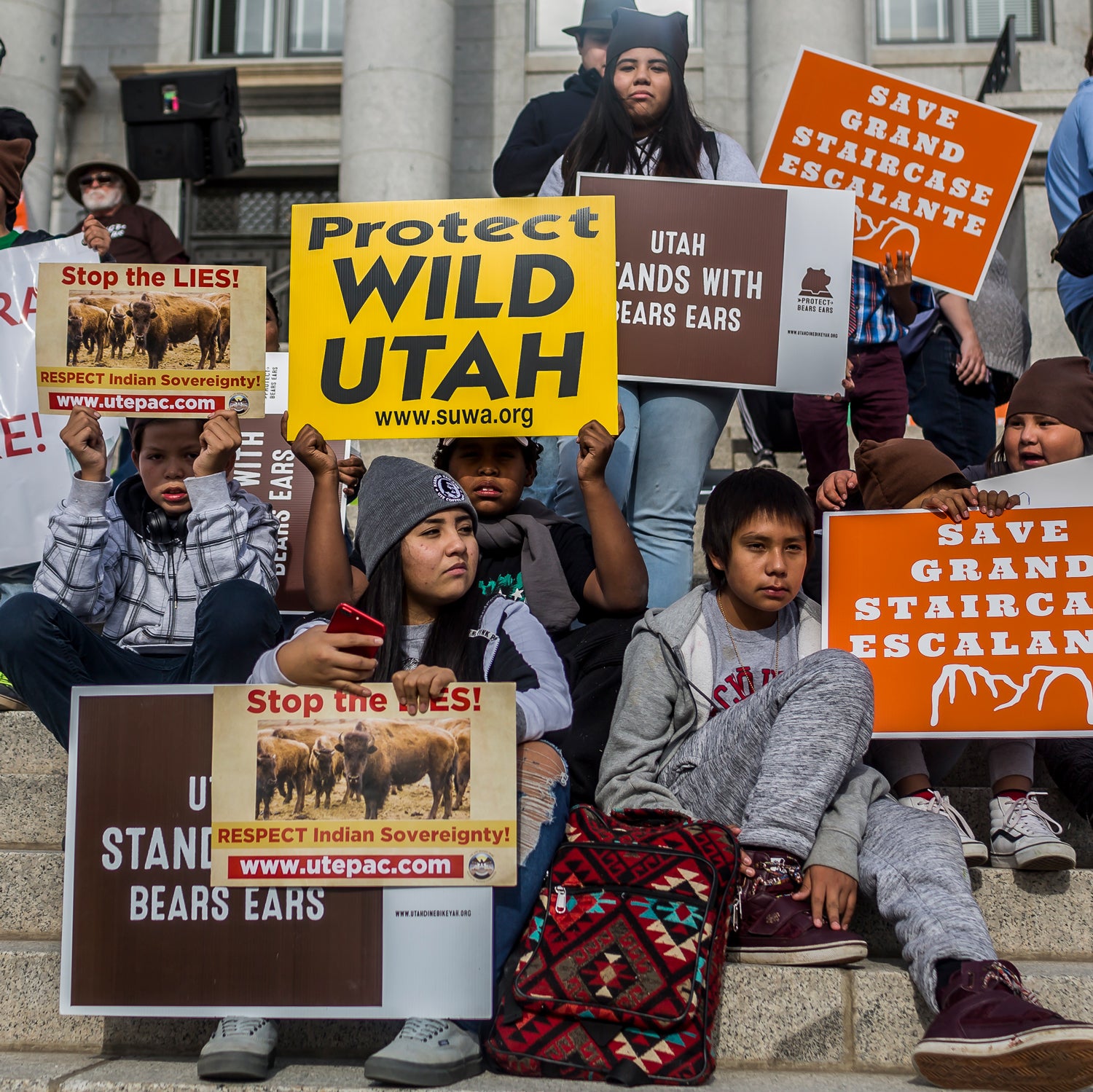On December 15, 2016, four members of UtahÔÇÖs congressional delegation sent a letter to President Barack Obama, who was about to designate Bears Ears National Monument. The legislatorsÔÇösenators Orrin Hatch and Mike Lee, and representatives Rob Bishop and Jason ChaffetzÔÇötold Obama that a monument designation, made under the Antiquities Act, could harm some of their most vulnerable constituents.
ÔÇťSuch a unilateral designation infringes on the rights and the way of life of the Federally Recognized Indian Tribes in the area,ÔÇŁ they wrote. ÔÇťThis decision could abruptly and permanently close off a substantial area of land respected and used by generations of local Indian Tribes.ÔÇŁ
The letter was part of some 25,000 pages of documents by the New York Times that related to the Obama administrationÔÇÖs creation of Bears Ears, and President Donald TrumpÔÇÖs downsizing of it last year. The documents suggest that Utah and federal officials were motivated to change the monument boundaries principally to free up potential mineral reserves. Along the way, documents show how these leadersÔÇöincluding that group of four in their December letterÔÇömisrepresented or ignored the Native American voices that sparked the monumentÔÇÖs creation.
ÔÇťItÔÇÖs in keeping with the incredibly paternalistic view that the Utah delegation has shown to date,ÔÇŁ says Ethel Branch, the Navajo NationÔÇÖs attorney general who is suing the Trump administration over downsizing the Bears Ears monument. ÔÇťItÔÇÖs just a disregard for tribes as governments.ÔÇŁ
In 2011, Navajo activist group Utah Din├ę Bik├ęyah called for the area to be protected in some fashion. Five years later, the Bears Ears CommissionÔÇömade up of representatives from the Hopi, Navajo, Ute Mountain Ute, Ute, and Zuni tribesÔÇöformally requested a national monument designation from Obama. It was the first monument proposal driven by Native Americans, and ObamaÔÇÖs designation gave the commission an integral role in deciding how to manage the monument.
But the Times documents show that the commission, under the Trump administration, was given no such role. In a letter dated March 17, 2017, the Bears Ears Commission told Interior Secretary Ryan Zinke and Michael Scuse, then the acting secretary of the Department of Agriculture, that the tribes it represents were ready to fulfill their end of the management agreement. Of Zinke and TrumpÔÇÖs reported interest in shrinking or doing away with Bears Ears, they wrote, ÔÇťWe would consider it essential that we are able to have full discussions with you about those possibilities. Of course, from our standpoint, any such actions would be absolute tragedies.ÔÇŁ
Instead of establishing a communication channel with tribes, the emails show that as soon as Trump took office, the Department of the Interior and Utah officials began an exhaustive survey of the mineral potential in the area, while ignoring tribal calls for a seat at the table. (The Interior Department never responded to the commissionÔÇÖs March letter, and several people on the commission told ║┌┴¤│ď╣¤═° there was almost zero communication from ZinkeÔÇÖs office.) A staffer for Senator Hatch even offered up a map in March 2017 with boundaries ÔÇťthat would resolve all known mineral conflicts.ÔÇŁ Even among monument allies, the tribes got short shrift. During ZinkeÔÇÖs May 2017 trip to Bears Ears, according to a schedule in the Times emails, he spent three hours apiece with Friends of Cedar Mesa and a group of outdoor industry executives, while the Bears Ears Commission received just an hour.
To the Bears Ears Commission members, all of them elected leaders of tribal nations, the notion that a county commissioner should be elevated to their level was an insult on tribal sovereignty.
That meeting, according to a summary published in the Times documents and follow-ups ║┌┴¤│ď╣¤═° made with people in the room, was uncomfortable. Charles Wilkinson, a University of Colorado law professor who was present, presented Zinke in the summary as ÔÇťill-informed on the Antiquities Act and tribesÔÇŁ and initially dismissive of claims the tribes had repeated ad nauseum. Wilkinson wrote that the tribal leaders present ÔÇťexplained that, yes, it really does make a difference to have a monument declared; no, there is nothing wrong with the collaborative management; yes, this really is sacred land to the tribes; and so forth.ÔÇŁ
Branch and Shaun Chapoose, the Ute tribeÔÇÖs representative on the Bears Ears Commission, agreed that Zinke was unprepared for the meeting, but said that he seemed more open to tribal concerns as the conversation went on. Significantly, Zinke promised no recommendation would take place without further conversation. ÔÇťThe assumption we had was that he would come back and talk to us after he visited, but we didnÔÇÖt hear anything after that,ÔÇŁ Chapoose says. (The Interior Department did not respond to a request for comment.)
Instead, Zinke┬áwent on the public record saying things┬áthe Native representatives call untrue, like that the monument, or that the monument ÔÇťtraditional uses.ÔÇŁ
The Bears Ears Commission deconstructed many of these arguments, point by point, in a scathing letter to Zinke that July:┬ácontrary to ZinkeÔÇÖs public comments, the commission wrote, the tribes were not happy with his interim report on Bears Ears;┬áshrinking the monument would remove protection from one of the most archeologically and historically rich places in the West;┬áand they were content with the collaborative management scheme Obama laid out. (The inaccuracies persist: Senator Lee, in a Senate hearing last week, said the Bears Ears monument would have restricted the religious freedom of Native Americans nearby.)
Members of the commission also chafed at ZinkeÔÇÖs repeated insistence that a San Juan County commissioner, Rebecca Benally, have a seat on the management group. Benally is Navajo and opposed the monument, and she routinely appeared with Hatch and other Utah leaders in . To the Bears Ears Commission members, all of whom are elected leaders of tribal nations, the notion that a county commissioner should be elevated to their level was an insult. ÔÇťState and local government representatives elected by San Juan County residentsÔÇŽdo not represent the sovereign Navajo Nation government, or any other Indian NationÔÇÖs government,ÔÇŁ they wrote in the July letter.
ÔÇťItÔÇÖs something you think of more as a 19th-century phenomenon, the type of paternalism where ÔÇśwe know best,ÔÇÖ and the idea that tribes are not really able to compete or understand the way things work,ÔÇŁ University of Utah history professor Greg Smoak says of the diplomatic strategy with tribes.
Yet despite the commissionÔÇÖs protests, in December 2017, President Trump, with Benally and Zinke by his side, cut Bears Ears into two monuments, reducing them to a combined 15 percent of the original size.
The Times documents bolster arguments that while Hatch, Lee, Zinke, and others may have claimed to care for Native interests, they did so only in a superficial manner, and their real concerns were the mineral deposits. Then again, you donÔÇÖt need the Times emails to come to this conclusionÔÇö: ÔÇťThe Indians, they donÔÇÖt fully understand that a lot of the things that they currently take for granted on those lands, they wonÔÇÖt be able to do if itÔÇÖs made clearly into a monument or a wilderness.ÔÇŁ


